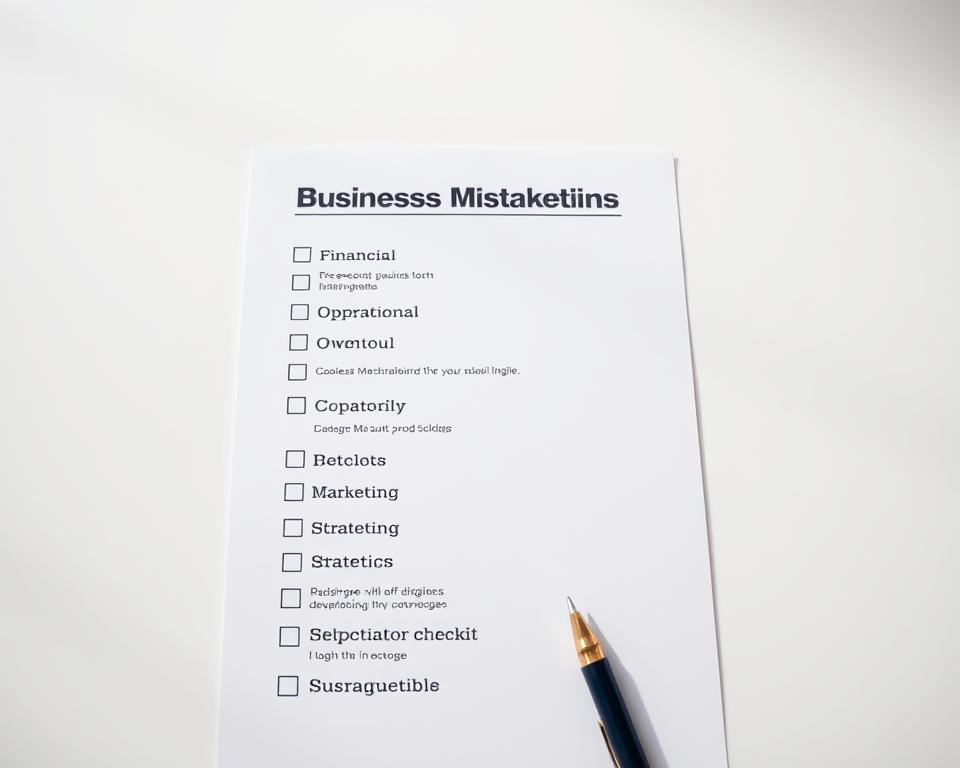Annunci
Can a short, practical plan really cut your risk in half? If you lead a team or run operations, this article offers a plain-English guide to spotting trouble early and acting fast.
This resource focuses on prevention and continuous improvement. It pulls in clear data — the U.S. Bureau of Labor Statistics notes over 18% of new businesses fail in the first two years, and more than 55% close by year five. A 2020 PNAS study found 43% of small owners temporarily shut during early 2020, and the Federal Reserve estimated about 200,000 permanent closures that year.
Use these findings as a roadmap, not a guarantee. You’ll get steps to spot early warning signs, prioritize high-impact fixes, and know when to call in legal, financial, or marketing experts.
What you’ll get: a concise article that shows where things go wrong, real examples, and practical actions you can adapt to your context. Read on to learn how to protect your time, customers, and team.
Introduction: Why business mistakes still happen—and how to reduce the risk today
Even today, limited time and cash leave many operators exposed to preventable setbacks. The U.S. context matters: the Bureau of Labor Statistics reports over 18% of new ventures close within two years and more than 55% shut by year five. A 2020 PNAS study found 43% of small business owners temporarily closed early in 2020, and the Federal Reserve estimated roughly 200,000 permanent closures that year.
Annunci
What this means for you: market uncertainty often collides with scarce people, money, and time. That friction, not a lack of ideas, explains why common errors persist. This guide helps you prioritize actions that protect cash flow, customer relationships, and time.
Use this guide as a working tool. Treat each section as an experiment: define expected outcomes, run small tests, measure results, and iterate. Mark the parts that fit your stage, assign owners and timelines, and bring in qualified advisors for legal, tax, or employment questions.
- Anchor fixes in current U.S. realities—survival stats, shifting demand, and supply limits.
- Focus on quick research and customer feedback to cut risk without overanalyzing.
- Apply changes in phases to protect runway and maximize ROI.
Skipping a real plan: Turn vision into an actionable, flexible business plan
Turning a big idea into a short, usable plan stops guesswork and helps you act fast. A living plan keeps assumptions visible and metrics measurable so you can test ideas without draining money or time.
Annunci
What to include:
- Market and buyer: define your target customer and why they will choose your product.
- Value and pricing: simple pricing model with unit economics and average order value assumptions.
- Channels and tests: prioritize SEO, email, and one paid channel; list test order and success criteria.
- Operations and roles: note lead times, fulfillment approach, and what you outsource in the first 90 days.
- Financials: 12-month revenue forecast, gross margin, operating expenses, and cash triggers.
Example (one page):
EcoTote Co. — Target: eco-conscious urban professionals. Price: $28 AOV. Channels: organic content + email first. Ops: print-on-demand + 3PL. Goal: 1,000 customers in 12 months; 55% gross margin.
Set a review cadence: weekly metric checks, a monthly plan review, and quarterly strategy updates. Keep the plan visible in your project tool so every owner aligns decisions to the plan.
Ignoring market research and customer feedback loops
Quick, low-cost research saves you time and money before you build a product. Treat research as a routine habit, not a one-off task.
Validate demand before you commit: interview 10–15 target customers and run a landing page that captures emails for a single offer. Use those sign-ups as a buying signal before ordering inventory.
Validating demand before you build: quick tests and interviews
Review competitors’ reviews, FAQs, and content to spot gaps. Note pricing anchors and the language customers use.
Run small “smoke tests” with low-budget search or social ads to measure clicks and email sign-ups. If the click-through and sign-up rates are poor, iterate the offer—not the whole product.
- Use short post-purchase surveys to learn why customers bought and what almost stopped them.
- Close the loop with a monthly customer panel call to test prototypes and messaging.
- Track core signals: sign-up rate, top objections, and the exact phrases customers use to describe value.
Let people describe their problem in their own words, and mirror that wording on your website and content.
Document and share insights in your plan and revisit research quarterly. Start small: learning fast costs far less than fixing a mispositioned launch.
Misunderstanding cash flow, margins, and runway
Cash tightness is often a timing issue—know when money comes in and when it must go out. Start by building a rolling 13-week cash flow model that lists weekly receipts (sales, refunds) and disbursements (COGS, payroll, rent, software, marketing). Update assumptions each week so timing and gaps surface early.
Cash flow basics: forecasting receipts, disbursements, and timing
Use conservative timing: invoices clear late, inventory needs cash up front, and processors sometimes hold funds. Include a 5–10% contingency for unexpected things.
Updated benchmarks and a simple profit scenario
Shopify notes many small companies spend roughly $40,000 in year one—use that as a starting point and tailor to your market and product mix.
Example: 10,000 visits/month × 1.5% conversion × $100 AOV × 30% net margin ≈ $4,500 profit/month before returns and ad CAC.
- Track gross margin by product and channel; favor higher-margin products to extend runway.
- Set spend thresholds: pause ads if CAC exceeds target for two weeks; reorder only when cash and lead times align with demand.
- Share the model with people in your company so owners understand trade-offs and timing.
Make forecasting a habit. Weekly reviews and small wins—better conversion, slight AOV lifts—can materially improve runway without adding more money.
Wasting time and money on the wrong work
Too many owners fill their days with low-value tasks that drain runway and focus. Protect your calendar by choosing three weekly outcomes that directly affect revenue or customers, and do those first.
Automate and batch routine admin—invoice runs, inventory syncs, and email flows. Batching similar tasks reduces context switching and saves time for high-impact work.
Outsource repetitive tasks like data entry, product uploads, and bookkeeping so you, as the owner, can focus on sales, service, and partnerships. This is often cheaper than losing margin when a person at $40/hour spends 10 hours on a task a freelancer can do for $150.
- Define, time-box, and review tasks to keep the team aligned on outcomes over activity.
- Keep a clear “not this week” list and a stop-doing list for items that didn’t move metrics in 30 days.
- Reassess recurring meetings and reports; shorten or remove anything that doesn’t serve customers or cash flow.
Track the time–money trade-off: if the math favors outsourcing, free your people for higher-leverage work.
Small, repeatable process changes—automate where it matters, cut non-essential tinkering, and learn from each mistake—will protect time and help you scale without burning cash.
Overcomplicating your product mix and value proposition
When you simplify what you sell, operations get easier and your marketing message sharpens. A narrow offer helps you spend less time on low-return things and more time serving your core customers.
Focus beats breadth for small brands
Why it matters: adding products when one underperforms often dilutes your brand and ties up money in inventory. Shopify has noted this pattern, and Business News Daily stresses defining your target market first.
Make focus practical:
- Start with a tight product line that solves one clear customer problem. Expand only after demand is proven.
- Cut slow-moving SKUs. Keep items that drive margin and reorder velocity; remove those that complicate fulfillment.
- Write a one-sentence value pitch: who you serve, the problem you fix, and why your solution wins.
- Test new ideas with small batches or preorders to avoid inventory risk.
- Align your content, ads, and merchandising to a single promise so customers know exactly why to choose you.
Example: an eco-friendly bag brand keeps core SKUs and bundles instead of chasing unrelated lines, improving delivery reliability and margins.
Review monthly and keep a backlog of ideas. Add new products only after you hit adoption and retention milestones so you protect cash and keep people focused on value.
Underinvesting in marketing strategy and organic growth
A weak marketing plan can quietly eat runway and stall long-term growth. You need a mix of organic content, SEO, and paid channels that matches your goals and cash limits.
Why this mix matters: Shopify reports about 70% of clicks go to organic search and the top five organic results capture 67.6% of page-one clicks. Marketers with a documented strategy are 313% more likely to report success. That means durable content and SEO compound profit over time.
Balancing organic and paid
- Document your strategy: set clear goals, ICPs, and channel roles so owners and teams align.
- Use paid ads to test messages fast, but cap spend until CAC meets targets.
- Measure cohorts: track LTV by channel to guide where to send money and time next quarter.
Build an audience around interests
Focus your website and content on what customers care about—wellness, sustainability, or lifestyle—rather than only product specs. That draws repeat visitors and makes email and social more effective.
Practical steps: create a content calendar for education, comparison, and post-purchase content; capture emails with useful lead magnets; gather feedback via surveys and interviews to refine topics.
Launching too quickly—or too slowly—without operational readiness
A launch succeeds when your systems handle the real world, not just the ideal plan.
Define launch-readiness: test checkout flows, publish clear payment terms, have standard contracts, and confirm fulfillment SLAs. Train your support team on common questions and escalation paths so customers get fast, consistent responses.

Move too fast and you risk failed orders, slow shipping, and refunds. Move too slow and you burn time and money while competitors capture demand.
Quick readiness checklist:
- Tested order and checkout end-to-end (include a return).
- One-page SOPs for order handling, returns, and customer messages.
- Published ToS, privacy, and warranty terms that match your site language.
- Inventory, packaging, and label workflows validated with small batches.
- Analytics and event tracking live so you measure what matters day one.
Run a soft launch (friends or a pilot cohort) and complete a dry run of 10 test orders, including an exchange. Then schedule a post-launch review to capture lessons and update your plan.
Hiring too soon, too late, or the wrong roles
Bringing on staff at the wrong time drains runway and distracts from what matters most: customers and product. You need a hiring approach that matches your growth stage and your plan.
Start with generalists. Early on, hire or contract versatile people who can wear multiple hats while you validate demand and product fit. This saves money and keeps momentum when priorities shift.
When to add specialists
Add specialists once a process repeats and shows clear ROI—when lifecycle email lifts LTV, or a repeatable channel needs scale. At that point, a focused hire can deliver measurable growth.
- Tie hires to milestones: revenue, gross margin, or customer volume so payroll matches runway.
- Use contractors first to test fit and scope before committing to a full-time employee.
- Define clear outcomes for each role; avoid vague requests like “help with marketing.”
- Share your website roadmap, operating plan, and customer insights so new people ramp fast.
Use a hiring scorecard to evaluate candidates fairly and reduce bias. Review capacity every quarter to prevent burnout or idle payroll. Keep a bench of freelancers for peak periods so you manage growth without permanent overhead.
Business News Daily notes hiring too early is common; part-timers or subcontractors often protect cash while you learn.
Doing everything yourself and delaying expert help
Wearing every hat in your company keeps you from leading where you add the most value. You can do a lot, but some tasks cost more in lost time and risk than they do in fees.
Surrounding yourself with advisors pays off. Business News Daily advises leaning on experts rather than trying to run everything alone. Shopify highlights the opportunity cost of DIY work and suggests automating or outsourcing routine tasks.
- When to hire a CPA: set up chart of accounts, sales tax, and payroll to avoid messy cleanups.
- When to call an attorney: entity selection, contracts, and privacy policies that fit your model.
- When to use specialists: bring in content, lifecycle email, or analytics pros when they can move metrics fast.
Create a simple intake process for freelancers: brief, timeline, deliverables. Run short trials and track ROI so you can scale what works.
Avoid waiting until a costly error forces you to react; proactive advice usually costs less than fixing a major problem later.
Keep strategy in your hands and delegate execution. That protects your time and helps you focus on customers and growth.
Legal blind spots that trip up new businesses
One overlooked contract or missing permit can stop operations overnight. Small legal oversights often cost more in time and money than the initial counsel would have.
Practical legal hygiene fixes: set up the right entity, keep governance papers current, and use written agreements for people and vendors. These steps reduce personal exposure and make decisions cleaner when growth arrives.
Entity selection and governance
Choose an LLC or corporation to separate personal assets from company risk. Align that choice with tax needs and funding plans.
Maintain an Operating Agreement or bylaws so owners know voting rights, equity splits, and dispute paths. Keep a current cap table and record board consents for major orders or funding events.
Contracts, securities, and permits to track
Use written agreements for co-founders, contractors, employees, customers, and vendors. Verbal promises create unclear expectations and costly disputes.
If you accept outside capital, follow securities rules—use proper disclosures and filings. Don’t take investor funds casually; treat each round as a formal event.
Identify required licenses and permits by industry and location. Calendar renewals so an expired permit won’t halt sales or operations.
“Treat legal spend as risk management: proactive advice preserves momentum.”
- Review IP assignment and non-compete clauses with counsel before hiring or contracting.
- Publish clear terms and policies; ensure website terms match how you operate.
- Set a legal ops plan: what gets reviewed, who signs off, and when to escalate.
Final note: consult a licensed attorney and CPA for tailored advice. A small, early investment in legal structure prevents a major mistake later and protects your team, plan, and capital.
Data protection, online compliance, and customer trust
Protecting customer information starts with simple, repeatable steps you can embed in daily operations. Treat privacy as a product area: document what you collect, why, and where it lives.
- Publish a clear privacy policy and cookie notice that match your site practices, and log consent where required.
- Use PCI-compliant payment processors; never store full card data on your website servers.
- Map data flows—who accesses what—and limit access to only necessary employee roles.
Operational controls reduce risk. Keep systems patched, use MFA and strong passwords, and review third-party app permissions on a schedule.
Train your team on phishing and secure handling of customer service records. Document an incident response process and test it so you can act quickly if a breach occurs.
Align your terms and practices—consistency builds trust and lowers legal exposure.
As you expand into new regions, reassess rules and payment standards. For specific legal or audit questions, consult a qualified attorney or security specialist to verify compliance for your operation.
Neglecting intellectual property and brand protection
Protecting your brand starts long before sales begin—small steps now prevent costly copies later. If you want your company and products to keep value as you grow, make IP part of routine planning.
Trademarks, copyrights, patents, and monitoring infringements
Start with the basics: search and file trademarks for your name and logo in the classes that match your market and planned expansion.
Copyright original content and creative assets so you can enforce rights and license work. If you have a protectable invention, consult a patent attorney early to assess novelty and strategy.
- Use NDAs and assignment agreements with employees and contractors so IP stays with the company.
- Register domains and social handles defensively to protect online presence.
- Monitor marketplaces and social platforms for infringing listings; set up alerts and a takedown workflow.
Document brand guidelines so every owner and partner uses marks consistently. Train your team on proper use of third-party IP to avoid accidental infringement.
Treat IP as part of growth planning: protected assets can raise company valuation and make partnerships easier.
Prioritize filings that protect your most visible customer-facing assets first. That way you shield the parts of your product and brand that drive value and long-term growth.
Overpromising, underdelivering, and weak customer terms
Simple, accurate commitments cut disputes and save time and money for everyone. Clear promises set expectations and lower friction when orders slip or products need service.
Good terms protect both you and your customers. Publish readable warranties, returns, and service levels on your website and require consent at checkout. That small step reduces confusion and chargebacks.
Clear contracts, warranties, and service levels that protect both sides
Use order confirmations that restate delivery windows and support contacts. This one-page reminder limits surprises and guides customer action if something goes wrong.
- Match marketing to reality: don’t promise shipping or outcomes you can’t meet consistently.
- Be transparent: product pages must list specs, inclusions, and any limitations.
- Train people: teach employees how to handle exceptions with empathy and consistent rules.
- Capture feedback: log returns and refunds to find root causes and improve messaging.
- Review regularly: sample disputes quarterly and update terms as processes evolve.
“Avoiding contracts and overpromising often leads to disputes and damaged reputation.”
When your promises match your operations, customers stay calmer, support costs fall, and you protect your brand and cash.
Scaling and expanding before the model is proven
When demand looks real, the urge to expand can feel irresistible—fight it with data. Prove your unit economics and acquisition repeatability before you add headcount or long-term leases.
Look for three signals of readiness: positive unit margin, repeatable customer acquisition, and steady retention across cohorts. If these hold for multiple cycles, you can test one controlled expansion at a time.
- Stage growth: add one channel, one geography, or one product line and validate results for at least two full cycles.
- Protect cash flow: use milestone-based budgets and expand only when core metrics meet targets consistently.
- Document processes: clear SOPs let new people reproduce results without constant supervision.
Example: pilot a marketplace with a limited assortment before committing to inventory for a full rollout. Pilot results reveal real demand and hidden operational stress.
Business News Daily warns that expanding too quickly can backfire if early results are temporary, leading to overspending on staff and overhead without sustained demand.
Watch leading indicators like LTV/CAC and payback period, and lagging ones like cohort retention. Build capacity contingencies—contract manufacturers or 3PLs—so you can flex without fixed costs.
Share a simple scaling thesis with your team so everyone knows what “ready” means. Keep customers central: growth that degrades experience is not sustainable.
Common business mistakes to track and prevent continuously
Set a short operating rhythm so small issues are caught before they become crises.
Keep a monthly checklist that reviews plan drift, weak research, cash gaps, hiring missteps, unclear terms, and compliance. Assign an owner to each item and set a clear cadence.

Maintain a dashboard of leading indicators: customers, conversion, margin, and support backlog. Use it to spot trends before they hit the bottom line.
Run brief post-mortems on failures and near-misses. Document causes and translate findings into updated SOPs so the same mistake does not repeat.
- Collect and act on frontline feedback from customers and people who handle operations.
- Keep a running log of decisions and assumptions; revisit high-impact items quarterly.
- Hold a strategy refresh every quarter and use this guide as a standing agenda.
Celebrate improvements, not perfection: steady reduction in error rate matters more than flawless execution.
Conclusione
Before you finish, pick one or two high-impact ideas from this guide and schedule them this week.
Adapt each recommendation to your company, website, and customer reality. Context makes the right move clear.
Make sure you measure outcomes. Set simple goals, track progress, and change course fast when results lag.
Invest in foundational marketing and content that compound, then add paid growth once the math shows profit and repeatable growth.
Keep legal terms current as you scale and ask experts for high-stakes tax, employment, or data questions.
Build a habit of regular reviews and share this article with your team so people align on priorities and language.
There are no guarantees, but steady learning and focused execution raise your odds of a successful business.



